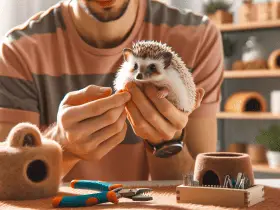Are you ready to embark on a wild and wonderful adventure with us? Join our community of hedgehog enthusiasts as we dive into the fascinating world of pet hedgehogs.
In this article, we’ll take you through a typical day in the life of these adorable little creatures. From their care and housing to their feeding and exercise routines, we’ll provide you with all the information you need to ensure your furry friend thrives in its new home.
So, let’s get started and discover what it truly means to have a pet hedgehog!
Key Takeaways
- A pet hedgehog requires a safe and comfortable environment with a spacious cage, soft bedding, and hiding places for privacy.
- Feeding and nutrition should include a variety of high-quality commercial hedgehog food, supplemented with fresh fruits, vegetables, insects, and lean meats to ensure proper nutrition and hydration.
- Exercise and enrichment are important for maintaining a healthy weight, muscle tone, and mental stimulation. Interactive toys and obstacle courses can encourage movement and exploration.
- Regular veterinary care, behavior monitoring, grooming, and a suitable habitat are essential for the overall well-being of a pet hedgehog. It is important to work together with a veterinarian to ensure the hedgehog’s health.
Hedgehog Care and Housing
When it comes to hedgehog care and housing, it’s important to provide a safe and comfortable environment for your pet. Creating a hedgehog-friendly home is essential to ensure their well-being and prevent any potential behavior problems.
First and foremost, it’s crucial to set up an appropriate cage for your hedgehog. They need plenty of space to roam around, so consider getting a cage that is at least four square feet in size. Line the bottom with bedding material such as fleece or paper-based litter, which helps absorb moisture and provides a soft surface for them to walk on.
Next, make sure the cage is equipped with hiding places like tunnels or igloos where your hedgehog can retreat when they want some privacy. Hedgehogs are nocturnal creatures by nature, so providing them with a dark and quiet sleeping area during the day is vital.
In addition to the physical environment, maintaining proper temperature and humidity levels is crucial for hedgehog health. Their ideal temperature range is between 72-80°F (22-27°C), while humidity should be kept around 40-60%.
Regularly cleaning and sanitizing the cage will help prevent any odors or hygiene-related issues. Provide fresh food and water daily, along with toys or interactive items to keep your hedgehog mentally stimulated.
Feeding and Nutrition
Feeding your hedgehog a balanced diet is essential for its health and well-being. As responsible hedgehog owners, we understand the importance of meeting their dietary needs and providing them with the best foods available.
Here are three key aspects to consider when it comes to feeding our prickly friends:
- Variety is key: Just like humans, hedgehogs benefit from a diverse diet. Offering a variety of high-quality commercial hedgehog food, supplemented with fresh fruits, vegetables, and insects ensures they receive all the necessary nutrients. This not only keeps them healthy but also adds excitement to their meals.
- Protein power: Hedgehogs require a protein-rich diet to thrive. Including lean meats such as chicken or turkey, as well as mealworms or crickets in their diet provides them with essential amino acids for growth and overall well-being.
- Hydration matters: Hedgehogs need access to fresh water at all times. Consider using a shallow dish that they can easily drink from without risk of drowning or spilling over.
Exercise and Enrichment
When it comes to our pet hedgehogs, exercise and enrichment play a crucial role in their overall well-being.
Interactive toys for stimulation are essential in keeping our hedgehogs mentally engaged and entertained.
Additionally, physical activity is of paramount importance as it helps maintain their weight, promotes muscle tone, and prevents obesity-related health issues.
Interactive Toys for Stimulation
Interactive toys are a great way to provide stimulation for your pet hedgehog. As owners, we want to ensure our little friends have a fulfilling and happy life. Here are three reasons why interactive toys are essential for your pet hedgehog’s mental stimulation:
- Promotes curiosity and exploration: Hedgehogs are naturally curious creatures, and interactive toys allow them to explore their environment in a safe and engaging way. Watching them investigate new textures, sounds, and movements can be both entertaining and heartwarming.
- Prevents boredom and loneliness: Hedgehogs thrive on mental stimulation, and without it, they can become bored or lonely. Interactive toys keep their minds active, preventing destructive behaviors like excessive digging or self-anointing.
- Strengthens the bond between you and your pet: Spending quality time with your hedgehog through interactive play strengthens the bond between you two. It fosters trust, creates positive associations, and enhances your overall relationship.
Importance of Physical Activity
Regular physical activity is crucial for keeping your pet hedgehog healthy and happy. Hedgehogs are naturally active animals, and exercise provides numerous benefits for their overall well-being. Not only does it help maintain a healthy weight, but it also promotes cardiovascular health and strengthens muscles. Additionally, exercise stimulates mental stimulation and prevents boredom, leading to a happier hedgehog.
There are several fun activities you can engage in with your hedgehog to ensure they get enough exercise. Consider setting up an obstacle course using tunnels, ramps, and platforms for them to explore. You can also provide them with toys that encourage movement, such as balls or puzzle feeders. Another great option is supervised free-roaming time outside of their enclosure.
Remember to always supervise your hedgehog during exercise sessions and provide a safe environment for them to play in. Regular physical activity not only keeps your pet hedgehog fit but also strengthens the bond between you both. So get moving with your spiky friend and enjoy the benefits of exercise together!
Grooming and Hygiene
Grooming and hygiene are important aspects of caring for a pet hedgehog. As responsible hedgehog owners, we want to ensure that our little spiky friends are clean and healthy. Here are three essential hedgehog grooming tips to keep your hedgehog looking and feeling its best:
- Regular Bathing: Giving your hedgehog regular baths is crucial for maintaining their hygiene. Use lukewarm water and a mild, unscented shampoo specifically designed for small animals. Gently lather the shampoo on their quills and belly, being careful not to get water in their ears or eyes. Rinse thoroughly and dry them off with a soft towel.
- Nail Trimming: Hedgehogs have sharp claws that can easily scratch both themselves and us. To prevent any accidents, it’s important to regularly trim their nails using small animal nail clippers or human nail clippers with rounded edges. Take caution not to cut too close to the quick, which can cause bleeding.
- Ear Cleaning: Hedgehogs are prone to earwax buildup, which can lead to infections if left untreated. To keep their ears clean, use a cotton swab dampened with mineral oil or a specialized ear cleaning solution recommended by your veterinarian. Gently wipe away any visible dirt or wax from the outer part of their ears.
Sleep Patterns and Habits
Hedgehogs are nocturnal animals, so they typically sleep during the day and become more active at night. As pet owners, it’s important for us to understand their sleep patterns and how we can provide a comfortable environment for them to rest.
Temperature control plays a crucial role in a hedgehog’s sleep routine. These small creatures prefer temperatures between 72-80°F (22-27°C), as this mimics their natural habitat. It’s essential to keep their sleeping area warm and draft-free, ensuring they can relax and get the quality sleep they need.
Daylight also has a significant impact on hedgehog sleep patterns. Exposure to natural light during the day helps regulate their internal clock. Keeping their enclosure near a window or providing artificial lighting that mimics daylight can help establish a consistent sleeping schedule for your pet hedgehog.
Creating an ideal sleeping environment is vital for your hedgehog’s overall well-being. By maintaining proper temperature control and considering the impact of daylight on their sleep patterns, you can ensure that your furry friend gets the restful slumber they need.
Socializing and Bonding
When it comes to bonding with your hedgehog, spending quality time together is essential for building a strong and trusting relationship. Here are three bonding activities and socializing tips that will help you establish a deep connection with your prickly companion:
- Cuddle Time: Hedgehogs may seem prickly on the outside, but they love gentle physical contact. Take some time each day to cuddle with your hedgehog by gently cradling them in your hands or letting them snuggle up against you. This close physical contact will help foster feelings of security and warmth.
- Playtime: Hedgehogs are curious creatures who enjoy exploring their surroundings. Create an enriching play area for your hedgehog by setting up tunnels, toys, and hiding spots where they can roam freely. Engage in interactive play sessions using toys like small balls or puzzle feeders that encourage mental stimulation and physical activity.
- Scent Bonding: Hedgehogs have a keen sense of smell, so introducing them to different scents can be a great way to bond. You can wear a clean piece of clothing inside their cage for them to associate your scent with safety and familiarity. Additionally, try offering treats from your hand to build positive associations between food and human interaction.
Health and Veterinary Care
To ensure your hedgehog’s well-being, it is important to schedule regular visits with a veterinarian who specializes in exotic pets. Hedgehogs are unique creatures that require specific care and attention to maintain their health. Regular veterinary check-ups play a crucial role in ensuring your hedgehog remains happy and healthy.
During these visits, the veterinarian will conduct a thorough examination of your hedgehog, checking for any signs of illness or injury. They may also perform necessary vaccinations and provide advice on proper diet and exercise for your pet.
Hedgehog health maintenance involves more than just routine vet visits. As an owner, it is important to monitor their behavior and physical appearance closely. Look out for any changes in appetite, activity level, or the presence of parasites such as fleas or ticks. Regular grooming sessions can help keep their quills clean and prevent matting.
In addition to veterinary care, providing a suitable habitat for your hedgehog is essential for its overall well-being. Ensure they have a spacious cage with appropriate bedding material, temperature regulation, hiding spots, and exercise wheels.
Remember that maintaining good hedgehog health requires teamwork between you and your veterinarian. By scheduling regular veterinary visits and practicing proper at-home care, you can ensure that your hedgehog lives a long and healthy life as part of your family.
Handling and Taming
During handling and taming, it’s important to approach your hedgehog with patience and gentleness. Hedgehogs are naturally shy creatures, so it may take some time for them to feel comfortable around humans. Here are three key things to keep in mind when working with your hedgehog:
- Create a calm environment: Hedgehogs can be easily overwhelmed by loud noises and sudden movements. By providing a quiet and peaceful space, you will help your hedgehog feel safe and secure.
- Take it slow: Building trust takes time, so don’t rush the process. Start by simply spending time near your hedgehog’s enclosure, allowing them to get used to your presence. Gradually introduce touch by offering treats from your hand or gently stroking their quills.
- Use positive reinforcement: When training your hedgehog, focus on rewarding good behavior rather than punishing bad behavior. This can be done through treats or praise whenever they respond positively to handling or engage in desired behaviors.
Common Hedgehog Behaviors and Temperament
Hedgehogs can display a range of behaviors and temperaments, so it’s important to understand their unique personalities. These prickly creatures may not seem like the most expressive pets, but they actually have their own ways of communicating with us.
Hedgehog communication is mainly done through body language. They communicate happiness and contentment by staying relaxed and uncurling their spines. On the other hand, if they feel threatened or scared, they will curl up into a tight ball as a way to protect themselves.
When it comes to hedgehog territoriality, these little creatures can be quite possessive of their personal space. They establish territories within their cages or enclosures and may become defensive if someone tries to invade that space. This behavior is completely natural for them because in the wild, hedgehogs rely on establishing territories for survival.
Understanding these behaviors can help us create an environment where our hedgehogs feel comfortable and safe. By observing their body language and respecting their territorial boundaries, we can build trust with our pet hedgehogs and foster a strong bond.
Frequently Asked Questions
Can Hedgehogs Be Trained to Perform Tricks or Commands?
Yes, hedgehogs can be trained to perform tricks or commands. Hedgehog training techniques involve positive reinforcement and patience. Tips for teaching hedgehogs tricks include using treats as rewards and breaking down commands into small, manageable steps.
How Long Do Hedgehogs Typically Live as Pets?
Hedgehogs typically live as pets for around 4-6 years. However, with proper care and attention to their dietary needs, they can even live up to 8 years! Here are essential tips and tricks on how to care for a pet hedgehog.
Are There Any Specific Safety Precautions That Need to Be Taken When Handling a Hedgehog?
When handling a hedgehog, it’s important to practice safe techniques to prevent injury. Creating a hedgehog proof environment ensures their safety at all times. We’ll show you how!
Can Hedgehogs Live in Outdoor Enclosures or Are They Strictly Indoor Pets?
Outdoor enclosures for hedgehogs can be an option, but there are pros and cons to consider. It’s important to ensure temperature control as hedgehogs are sensitive to extreme temperatures.
Are There Any Particular Toys or Activities That Hedgehogs Enjoy for Mental Stimulation?
We’ve found that hedgehogs enjoy hedgehog puzzle feeders and DIY obstacle courses for mental stimulation. These activities provide them with both physical exercise and the mental challenge they need to stay happy and healthy.
Conclusion
In conclusion, owning a pet hedgehog can be an incredibly rewarding experience. From their adorable quills to their curious nature, these little creatures will quickly steal your heart.
Just like us, they require proper care and attention to thrive. By providing them with a comfortable habitat, nutritious food, and plenty of exercise and socialization, you’ll ensure their happiness and well-being.
So go ahead and let a pet hedgehog wiggle into your life like a soft melody that never fails to bring joy.
















Leave a Reply
View Comments